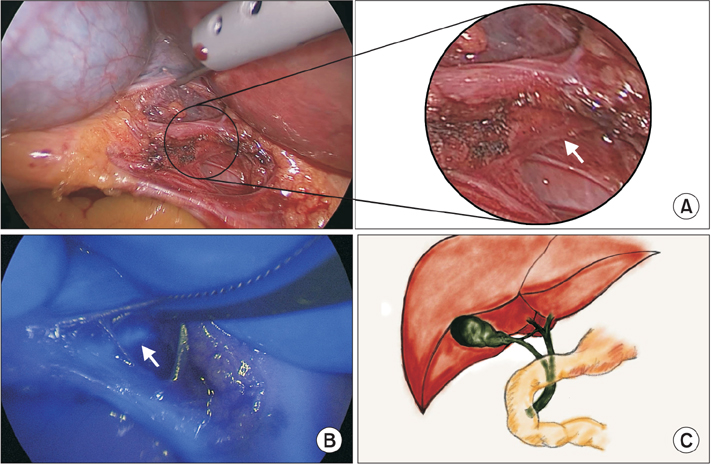Ann Surg Treat Res.
2017 Jan;92(1):47-50. 10.4174/astr.2017.92.1.47.
Cystic duct variation detected by near-infrared fluorescent cholangiography during laparoscopic cholecystectomy
- Affiliations
-
- 1Department of Hepatobiliary and Pancreas Surgery, Seoul St. Mary's Hospital, College of Medicine, The Catholic University of Korea, Seoul, Korea. gshth@catholic.ac.kr
- KMID: 2364714
- DOI: http://doi.org/10.4174/astr.2017.92.1.47
Abstract
- Near-infrared fluorescent cholangiography (NIRFC) is an emerging technique for easy intraoperative recognition of biliary anatomy. We present a case of cystic duct variation detected by NIRFC which had a potential risk for biliary injury if not detected. A 32-year-old female was admitted to the Seoul St. Mary's Hospital for surgery for an incidental gallbladder polyp. We performed laparoscopic cholecystectomy with NIRFC. In fluorescence mode, a long cystic duct and an accessory short hepatic duct joining to the cystic duct were found and the operation was completed safely. The patient recovered successfully. NIRFC is expected to be a promising procedure that will help minimize biliary injury during laparoscopic cholecystectomy.
Keyword
MeSH Terms
Figure
Reference
-
1. Flum DR, Cheadle A, Prela C, Dellinger EP, Chan L. Bile duct injury during cholecystectomy and survival in medicare beneficiaries. JAMA. 2003; 290:2168–2173.2. Archer SB, Brown DW, Smith CD, Branum GD, Hunter JG. Bile duct injury during laparoscopic cholecystectomy: results of a national survey. Ann Surg. 2001; 234:549–558.3. Khan OA, Balaji S, Branagan G, Bennett DH, Davies N. Randomized clinical trial of routine on-table cholangiography during laparoscopic cholecystectomy. Br J Surg. 2011; 98:362–367.4. Rothlin MA, Schob O, Schlumpf R, Largiader F. Laparoscopic ultrasonography during cholecystectomy. Br J Surg. 1996; 83:1512–1516.5. Sureka B, Bansal K, Patidar Y, Arora A. Magnetic resonance cholangiographic evaluation of intrahepatic and extrahepatic bile duct variations. Indian J Radiol Imaging. 2016; 26:22–32.6. Boni L, David G, Mangano A, Dionigi G, Rausei S, Spampatti S, et al. Clinical applications of indocyanine green (ICG) enhanced fluorescence in laparoscopic surgery. Surg Endosc. 2015; 29:2046–2055.7. Strasberg SM. Avoidance of biliary injury during laparoscopic cholecystectomy. J Hepatobiliary Pancreat Surg. 2002; 9:543–547.8. Dip FD, Asbun D, Rosales-Velderrain A, Lo Menzo E, Simpfendorfer CH, Szomstein S, et al. Cost analysis and effectiveness comparing the routine use of intraoperative fluorescent cholangiography with fluoroscopic cholangiogram in patients undergoing laparoscopic cholecystectomy. Surg Endosc. 2014; 28:1838–1843.9. Liu YY, Kong SH, Diana M, Legner A, Wu CC, Kameyama N, et al. Near-infrared cholecysto-cholangiography with indocyanine green may secure cholecystectomy in difficult clinical situations: proof of the concept in a porcine model. Surg Endosc. 2016; 30:4115–4123.10. Speich R, Saesseli B, Hoffmann U, Neftel KA, Reichen J. Anaphylactoid reactions after indocyanine-green administration. Ann Intern Med. 1988; 109:345–346.
- Full Text Links
- Actions
-
Cited
- CITED
-
- Close
- Share
- Similar articles
-
- Minimal invasive treatment of biliary leak after laparoscopic cholecystectomy
- Choledocholithiasis with a metallic clip after laparoscopic cholecystectomy
- Laparoscopic Resection for the Treatment of Symptomatic Remnant Huge Cystic Duct with Stone after Laparoscopic Cholecystectomy
- Laparoscopic cholecystectomy and common bile duct exploration for gallstone and common bile duct stone in a patient with a left-sided gallbladder: a case report
- Clinical Usefulness of Laparoscopic Cholangiography Compared to Endoscopic Retrograde Cholangiography in a Laparoscopic Cholecystectomy



